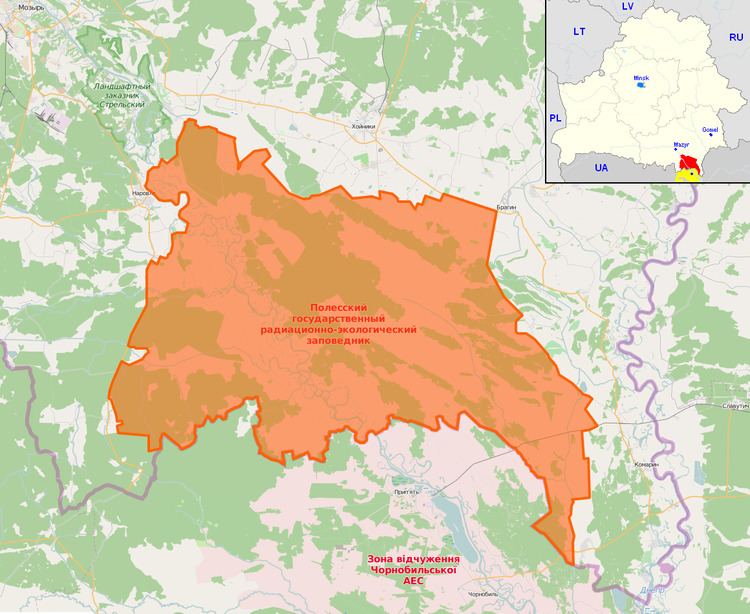Area 2,162 km² Phone +375 2346 33-086 | Address Belarus Established 1988 | |
 | ||
Similar ChERNO TUR, stantsiya Yanov, Pripyat amuseme park, Jupiter Plant, Rassokha Equipment Cemetery | ||
Polesie State Radioecological Reserve (Belarusian: Палескі дзяржаўны радыяцыйна-экалагічны запаведнік, Russian: Полесский государственный радиационно-экологический заповедник), is a nature reserve in Belarus, which was created to enclose the territory of Belarus most affected by radioactive fallout from the Chernobyl disaster. Also known as Zapovednik (Russian for "nature reserve"), it adjoins the Chernobyl Exclusion Zone in Ukraine. The environmental monitoring and countermeasure agency, Bellesrad, oversees the food cultivation and forestry in the area.
Contents
History
Two years after the Chernobyl disaster, the Belarusian part of the Chernobyl zone was extended to a more highly contaminated area. Then a closed nature reserve was established in Belarus with a total area of 1313 km². The reserve was established on July 18, 1988. Before the disaster, over 22,000 people lived there in 96 settlements. The population was evacuated after the disaster. In 1993 it was expanded by 849 km², making it the biggest Belarusian nature reserve and one of the biggest in Europe.
Overview
The area, located in southern Gomel Region and bordering the Ukrainian Exclusion Zone, includes part of the raions (districts) of Brahin, Chojniki and Naroulia. It is crossed by Pripyat River and the city of Mazyr is 36 km from the northwestern entrance at Naroulia. Its southern strip is crossed by the Chernihiv–Ovruch railway, that passes through the villages of Kaporanka, Kalyban and Pasudava.
Settlements
The following list shows the abandoned villages included in the reserve. Population refers to 1959 census, "fam." to the number of families evacuated after the 1986 disaster.
Fauna and flora
The reserve hosts many rare and endangered species, which thrive here thanks to the virtual absence of humans. They include bears, European bison, Przewalski horse, Golden eagle and White-tailed eagle. It is home to the world's largest population of the European marsh turtle. According to PSRER administration, there are 7 reptile, 11 amphibian, 46 mammal, 213 bird and 25 fish species. Of those, 70 are listed in the International Red Book and the Red Book of the Republic of Belarus. Flora includes 1251 registered plants, which is more than two-thirds of the flora of the country, and 18 are listed in the Red Book.
Reserve employee
State Reserve staff counts 700 people, 40 of them are academic degree holders.
Activities
Although the reserve was established for the purpose of radiobiological and environmental research, it is of interest to biologists. Due to the minimal human intervention, it is possible to observe the development of the wildlife in the conditions of Belarus. "In connection with the removal of anthropogenic load and the wealth of flora the ideal conditions for the recovery of the animal world have been created here", - states the report of the Committee on the Health Effects of the Chernobyl disaster at the Council of Ministers of Belarus. Some new species, including bison, were introduced on the territory of the reserve.
Main activities
Administration of PSRER is located in the town of Chojniki. The annual budget of PSRER is 4 million USD. Main activities include:
Extra-budgetary activities
The administration uses land in the reserve to earn income in addition to its budget. The purpose is to increase the self-sufficiency of the reserve, save money, increase the salaries of employees and contribute positively to the GDP of Belarus. Activities include:
Since 2004, there is a now 230-head herd on the reserve's horse farm. Cattle is being bred to endure the conditions of radioactive contamination, young individuals are sold for further breeding.
During all activities the content of radionuclides is being monitored in order to not exceed the limits.
